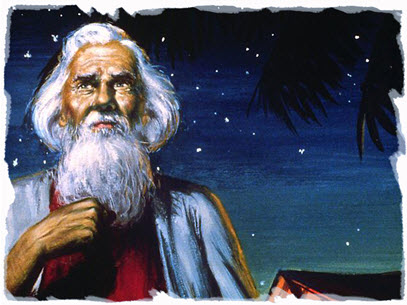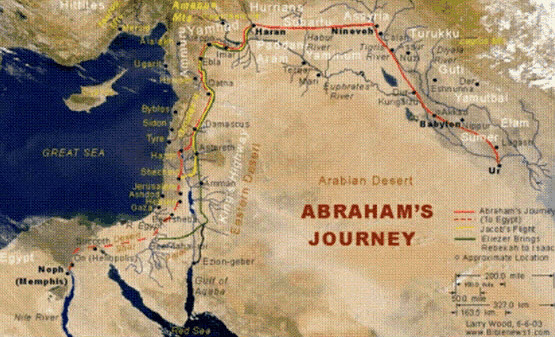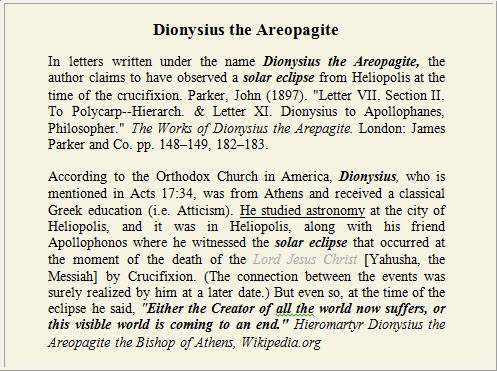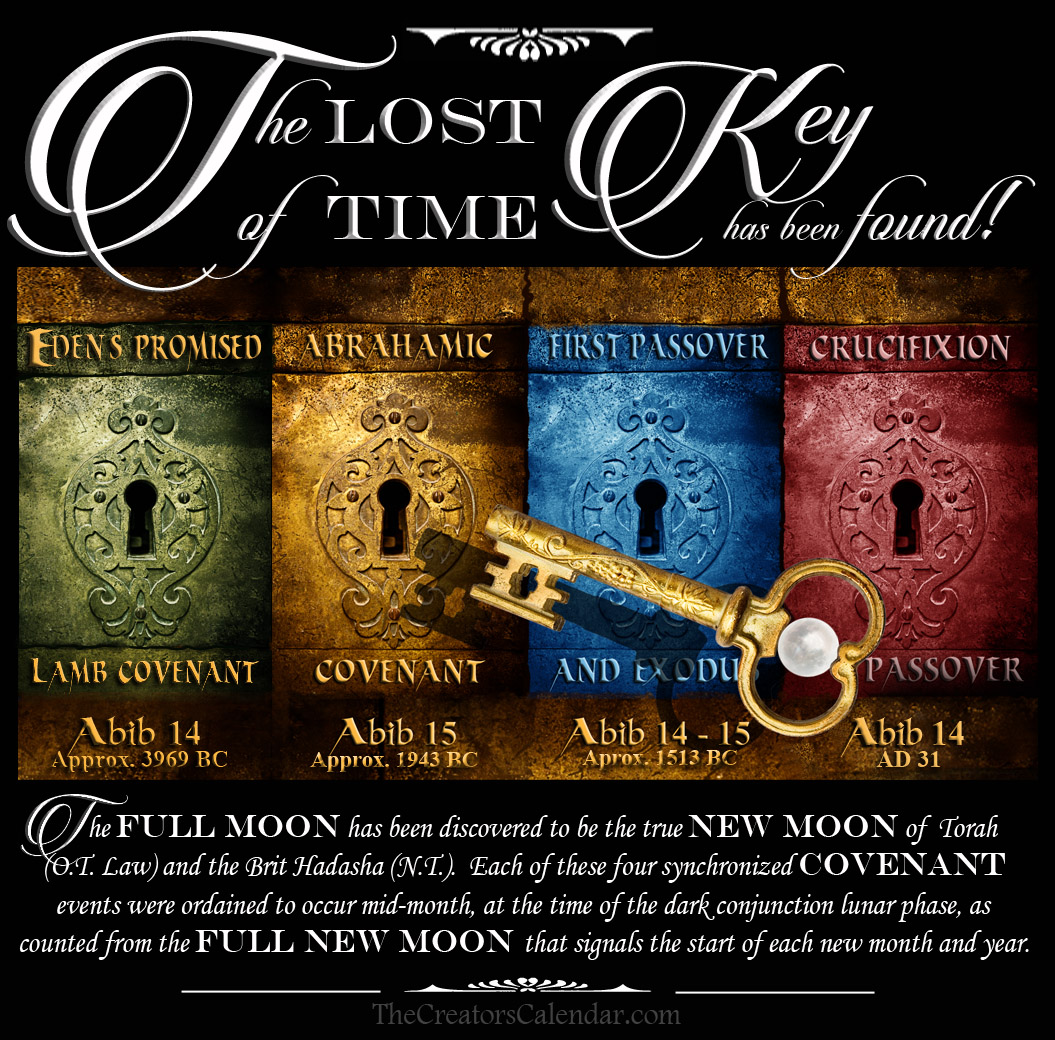The Night was Dark – Genesis 15
The Night Was Dark – Genesis 15
430 Years Prior to the Exodus, to the Very Day
 Genesis 15:12, 17
Genesis 15:12, 17
The purpose of this Hebrew interlinear word study is to identify which mid-month lunar phase marked the first Passover, the 14th of Abib, and the great Exodus from Egypt that followed the next night. Once that is determined, we can have the assurance of locating the true and authentic New Moon of Scripture. If we ask the Rabbinical Pharisee Jews, who keep a dark lunar phase as their New Moon, or Karaite Jews, who keep the first visible crescent, they would authoritatively declare that the middle of the month lunar phase is the full moon. But although they speak from nearly 2,000 years of oral traditions (Babylonian customs), the weight of evidence in Scripture does not support either view.
But search as one might, no clues are given among the written records of the monumental Exodus event. However, all is not lost! It has been discovered that there are two Scripture witnesses that boldly testify to that mid-month lunar phase so that none may be without excuse. The first witness comes from the Old Testament Torah, which links the night of the Exodus with the night Yahuah Alahim instituted His covenant with Abraham 430 years earlier, to the very day, the 15th of Abib. The second witness comes from the New Testament, as found in Luke, who described the great solar eclipse that occurred on the day of our Messiah’s Crucifixion, the 14th of Abib. Might these two dark lunar phase events (Covenant with Abraham and the Messiah’s crucifixion), separated by nearly 2,000 years, be the missing links? Might these two epic events in time resolve the identity of the authentic and original New Moon that synchronized the Exodus with that of Eden to complete four cohesive cornerstones of evidence for the real New Moon? Let’s take a look.
The Calling of Abraham
Yahuah Alahim called Abram out of the Ur of the Chaldeans and led him on a faith journey to the Promised Land. Because of Abram’s trusting obedience, Yahuah made a covenant with him as a sign and guarantee, declaring that Abram (name changed to Abraham) would have an heir and that his descendants would be enslaved for 400 years and four generations, but then return to inherit the land we still call Yashar’al (Israel) today (Genesis 15:1-21).

“Now the sojourn of the children of Israel who lived in Egypt was four hundred and thirty years.” Shemot (Exodus) 12:40 NKJV
“And it came to pass at the end of the four hundred and thirty years—on that very same day—it came to pass that all the armies of the LORD went out from the land of Egypt.” Shemot (Exodus) 12:41 NKJV
“And this I say, that the law, which was four hundred and thirty years later, cannot annul the covenant that was confirmed before by God in Christ, that it should make the promise of no effect.” Galatians 3:17 NKJV
While there remains conflict in Scripture over the length of time Yashar’al (Israel) was actually under the yoke of Egypt, we concur with the weight of evidence that it was 430 years to the very day, for this was the time between the night that the covenant was first given to Abraham and when Yashar’al (Israel) was released from Egyptian bondage to the very day. Yahuah led his people out with a strong arm and a great pillar of fire in the middle of the lunar month on the night (Deuteronomy 16:1) of the 15th of Abib (Numbers 33:2-3).
First Witness – The Night Was Dark Genesis 15:17
While verse 12 above may appear to refer to a scary nightmare, verse 17 speaks of the physical sun setting and the sky being physically dark. While everyone knows that when the sun goes down, it is “night,” every night at sunset is not described as dark. Here, Genesis 15:17 describes in simple terms the appearance of the sky that particular night when the sun had set, “thick darkness came to be,” or as the NKJV puts it, “when the sun went down, it was dark.” This is the only place in Scripture where this seeming redundancy is stated. So what does it mean?
Only Three Lunar Phase Options for the Middle of the Month
There is no contention as to what day of the month this covenant with Abraham occurred. It was clearly the middle of the lunar month, specifically the fifteenth civil calendar date. The only question remaining is with regard to which lunar phase was present in that night sky. Remarkably, and by default, there are only three viable lunar phase options for the middle of the month. Either this mid-month event was the night of the “full moon,” the first visible crescent moon, or the “dark conjunction.”
So let’s compare the measurable differences of LIGHT at night from each of these three lunar phases when the sun has gone down, assuming the starlight is consistent each night:
- The full moon lunar phase arises in the east (H#6924 – kedem – front, that which comes before) either just prior or just following sunset. It is fully Air Jordan 1 Retro High Top 3 lit and visible by the time the stars come out, creating a “brilliant” light display as recorded in Revelation 12:1 (#4582 selene = brilliant moon). Predominantly, the full moon is considered a bright light source, and on this night it shines the entire night and creates a significant shadow on a sundial. Consequently, the night of the full moon is so brilliant that no torch or flashlight is necessary. This brilliant night is NEVER described as dark and by no means as thick darkness.
- The traditional New Moon recognized by the modern Karaite Jews and Muslims is the first crescent lunar phase. It becomes visible shortly after sunset at about 12 degrees above the western horizon at sunset, when the first stars begin to appear. It is visible for less than an hour. It emanates a very insignificant amount of light upon earth. Following sunset on the night of the crescent, although not considered moonless, 90% of the entire night is dark. As a result, this night of the crescent is never considered a brilliant or entirely dark. But is more in harmony with a dark night, especially during the hours after the crescent has set.
- The dark occulted lunar phase, recognized by the Rabbinical Pharisee Jews and NASA as the New Moon, is the only phase of the entire month that does not give any light upon the Earth for one or two nights on any given lunar month. This is because it intercepts the sun’s light as it physically comes between the Sun and Earth. This is the lunar phase that creates a solar eclipse once or twice a year. This is exactly what transpired on the day of the Crucifixion of our Messiah, in the middle of the month during the day, when the sun was darkened from the sixth to the ninth hour. For these reasons, the “conjunction” lunar phase is the solitary lunar phase that occurs when the night is at its darkest. For a full detailed account of the solar eclipse and its unusual length on the day or our Messiah’s crucifixion, refer to: The Sun was Darkened from the Sixth to the Ninth Hour.
If the moon did not exist any night, each night would appear to be the same as the next, notwithstanding the rotation adidas i 5923 clear yellow green color sheet music of the starry constellations along the east-west time continuum, which would continue to designate astronomical months. But since the dawn of human experience, the night of the full moon has never been described as dark, but in contrast, it is the night marveled at for its brilliance. So by the sheer weight of evidence from Genesis 15:12-17, the lunar phase of the 15th had to be the dark conjunction. Thus it is, by extension, fifteen days previous, the first lunar phase of the month, and a true New Moon must no doubt be marked by the full moon according to this one verse.
Second Witness – The Sun was Darkened From the Sixth to the Ninth Hour
It has been discovered in this Hebrew Study that the sun was darkened from the sixth to the ninth hour, fulfilling the ancient Amos 8 prophecy of a solar eclipse on the day of the Messiah’s crucifixion. Every time for 4,000 years prior to this dark day, this celestial three-hour phenomenon, magnified by Divine intervention, appears to have occurred during the dark conjunction lunar phase. By extension, the weighty evidence from this mid-month event portrays the original extraterrestrial New Moon to have always been the full moon fifteen days previous, at that epic appointed time nearly 2,000 years ago. For a full, detailed account of the solar eclipse and its unusual length on the day of our Messiah’s crucifixion, refer to The Sun was Darkened from the Sixth to the Ninth Hour.
Solar Eclipses
All solar eclipses occurring since the dawn of time have done ir jordan 11 bred game worn 1996 finals auctio so during a dark conjunction lunar phase and are observed somewhere on Earth during the daylight. This is when the moon visibly comes between the earth and the sun during the daytime, causing the sun to be obscured by the moon. With any mention of a “solar eclipse” or “darkened sun,” there is an automatic understanding that the lunar phase on that day is in conjunction with the earth and sun, thereby blocking the light of the sun.
Since this darkening of the sun was a daytime event, it cannot be construed in any way to be a lunar eclipse, as these are only visible during the night.

It is self-evident, according to the order of the lunar phases, that the New Moon must occur 15 days prior to a dark conjunction lunar phase or eclipse event. So, only if the New Moon is the “full moon” for the start of each month would it be possible for the dark conjunction phase to obscure the sun in a classic solar eclipse on the day of the crucifixion.
Three Recorded Scripture Eye Witnesses to the Solar Eclipse
It is a known fact that neither lunar eclipses nor solar eclipses last for a duration of more than a few minutes of total darkness and, by no means, never three hours of complete darkness. Yet, four eyewitnesses who are intricately familiar with the movements of the celestial bodies and whose names are recorded in Scripture lay claim that the “SUN WAS DARKENED” from the 6th to the 9th hour on the day of the crucifixion. This is the period between Noon and 3:00 P.M. on the modern clock. The primary clarification they each make is with regard to its unusual length. This, along with the intensity of the darkness, was the only difference between the occurrence of this “darkened sun” and all the previous darkened sun events, which are generally referred to today as “solar eclipses.”
Matthew
“Now from the sixth hour until the ninth hour there was darkness over all the land.” Matthew 27:45
Mark
“Now when the sixth hour had come, there was darkness over the whole land until the ninth hour.”Mark 15:33
Luke
“Now it was about the sixth hour, and there was darkness over all the earth until the ninth hour. 45ThenTHE SUN WAS DARKENED, and the veil of the temple was torn in two.” Luke 23:44-45
In the record of Luke above, it is of great importance to note that the word “then” does not exist in the Greek text. Translators added it later to make it appear that first, “there was darkness over all the earth, and then the sun was darkened.” This twist in meaning was designed to remove all connection to the natural TIME rhythm of a solar eclipse. But this is not the case. Instead, the phrase “the sun was darkened” was declared by Luke as the required explanation for why there was darkness over all the earth. These were not two separate events but one and the same event.
Individually, yet in one accord, each of the Renewed Covenant (NT) writers determined that the miracle of this “darkened sun” event lay in its profoundly unusual length. It was Luke alone who overtly stated the darkness over all the earth was directly related to the fact that “the sun was darkened,” but the others covertly stated it. But, you may ask, “How did both of the others really declare the darkness was related to the sun itself?”
The answer lay in the fact that they all identified the time of day as the 6th to the 9th hour. Remember, there are precisely 12 hours allotted by the ruling sun for every daylight, as presented on a sundial or divided in the sky (John 11:9). All agree that the sun was shining as usual from sunrise to the 6th hour. Then, the sun was obscured until the 9th hour. At the 9th hour, the sun was shining again as usual until it set at the end of the 12th hour, at its natural time. So, the “sun” ceasing to shine was predominately the focus of the darkness.
Dionysius the Areopagite (Greek Astronomer mentioned in Acts 17:34)
Living in Heliopolis at the time of the crucifixion of Yahusha, the Messiah, was the Greek Astronomer Dionysius the Areopagite. He described the events of that day as appearing to be the end of the world and clarified that there was a solar eclipse on that day. If this were simply a darkened sky, dark clouds, or a premature setting of the sun by six hours, he would have said so, as that would have been extraordinary. He had no reason to lie or cover up the truth regarding the sun being eclipsed by the dark conjunction lunar phase. Rather, he describes that “solar eclipse” as an epic event.
 If, as some have suggested, the full moon occurs mid-month on the 14th of Abib, in which a solar eclipse occurred, we can be confident that the trained eyes of these ancient students of the shamayim (heavens) would have recorded this most unusual occurrence in their testimonies. They would have each declared with enthusiasm that the moon had been moved either forward or backward by a full 180 degrees to place it in the position to darken the sun.
If, as some have suggested, the full moon occurs mid-month on the 14th of Abib, in which a solar eclipse occurred, we can be confident that the trained eyes of these ancient students of the shamayim (heavens) would have recorded this most unusual occurrence in their testimonies. They would have each declared with enthusiasm that the moon had been moved either forward or backward by a full 180 degrees to place it in the position to darken the sun.
But none of these four astronomically proficient men recorded anything of the sort. Amazingly, they were all silent on this point, which speaks equally as eloquently as what was recorded in their Scriptural statements. The sheer lack of evidence in Scripture for a “full moon” occurring on the mid-month date of the 14th of Abib during the crucifixion identifies this theory as modernly popular, yet with a faulty hypothesis. This is especially true as so much is provided with regard to the dark conjunction producing a solar eclipse on that strategic day.
Two Witnesses Synchronize Four Events
Might the Eternal Father, in His omniscience, have known that His authentic New Moon would become a point of controversy in the centuries following the crucifixion of His Son? This is supported by the calendar controversies brought to light by the discovery of the Dead Sea Scrolls. (Calendars in the Dead Sea Scrolls: Measuring Time by James C. Vanderkam.) In light of the fact that the modern Jews recognize either the dark conjunction or the first visible crescent as the New Moon, this should be a sign that they are NO LONGER in harmony with the Torah Law of Mosheh (Moses) since the time shortly after the crucifixion of the Messiah.
Might this have been the primary reason Yahuah Alahim placed the sign of authenticity for His mid-month DARK lunar phase of the 15th in the safety of the Abrahamic Covenant? A place where no one thought to look. Yet, from this unique vantage point, it can now be seen that this foundational covenant with Abraham both links and synchronizes the four most significant time-centric Scriptural events. By establishing the mid-month lunar phase, the authentic and original New Moon can be restored.
Eden’s Promised Messiah & Lamb Covenant
The Abrahamic Covenant & Promise of the Messiah
The Exodus and Messiah/Lamb Covenant
The Crucifixion of the Messiah and fulfillment of the Lamb Covenant
The Exodus Order of Events
- Yahuah led Mosheh (Moses) and Yashar’al (Israel) out of Egypt by night on the fifteenth of the first month at the conclusion of 430 years to the very day (Numbers 33:2-3; Exodus 12:40-42 and Deuteronomy 16:1-2).
- A month later, on the 15th, the people ran out of food and Yahuah provided quail that night and manna the next morning (Exodus 16:1-2) This is best read from the Septuagint version of Scripture, as it divides the verses correctly with comas and periods.
“And they departed from Elim, and all the congregation of the children of Israel came to the wilderness of Sin, which is between Elim and Sinai; and on the fifteenth day, in the second month after their departure from the land of Egypt, all the congregation of the children of Yashar’al (Israel) murmured against Moses and Aaron.” Shemot (Exodus) 16: 1, 2 Septuagint or LXX
- The third month, to the very day that Yashar’al (Israel) had left Egypt, Yahuah brought His people to the foot of Mt. Sinai (Exodus 19:1-2).
The Lost Key of Time is Found
These four synchronized events can never be separated, as they are forever united and linked by the following facts:
- The first month of the year, Abib.
- The 14th-15th day counted from the first lunar month.
- A dark lunar phase was in the middle of the lunar month.
- Because of the testimony of the two witnesses in Genesis and Luke, all four mid-month events occur in the dark conjunction lunar phase. By extension, this establishes the full moon as our Creator’s authentic and original New Moon.
So it is that we can know these 2,000 years later with certainty that Passover, the 14th of Abib, is always to be counted from the full moon as our Creator’s authentic and original New Moon. This places Passover, the 14th of Abib, consistently on a dark lunar phase. Consequently, the full moon perpetually remains the true New Moon today, just as it was at the time of Adam and Eve, Abraham, Moses, as well as Yahusha, the Messiah, as established on yet another principle of Scripture.
Only the authentic and original full New Moon will guide Yahuah’s true followers in how to synchronize their soul temples with His and when to assemble for worship. Only His ordained and unique time-measuring method will call His set-apart people to praise and worship on His monthly New Moon Days, weekly seventh-day Sabbaths, and annual Feast Days. Only one mid-month lunar phase harmonizes ir jordan 3 whataburger custom and links each mid-month event, beginning with Eden’s promised Messiah and LAMB covenant through to the Abrahamic and Mosheh covenants and is finally fulfilled by the Messiah, THE LAMB OF YAHUAH, WHO TAKES AWAY THE SINS OF THE WORLD.
Key Support Verses
- Exodus 12:40 – Now the sojourn of the children of Israel who lived in Egypt was four hundred and thirty years.
- Exodus 12:41 – And it came to pass at the end of the four hundred and thirty years, on the very same day, it came to pass that all the armies of Yahuah went out from the land of Egypt.
- Numbers 33:2-3 – Now Moses wrote down the starting points of their journeys at the command of Yahuah. And these are their journeys according to their starting points: They departed from Ramses in the first month, on the fifteenth day of the first month; on the day after the Passover the children of Israel went out with boldness in the sight of all the Egyptians. Numbers 33:2-3
- Deuteronomy 16:1 – Observe the month of Abib, and keep the Passover to Yahuah your Alahim, for in the month of Abib Yahuah your Alahim brought you out of Egypt by night. Deuteronomy 16:1-2
- Exodus 16:1-2 – On the fifteenth day of second month the Israelites ran out of food and complained of hunger.
“And they departed from Elim, and all the congregation of the children of Israel came to the wilderness of Sin, which is between Elim and Sinai; and on the fifteenth day, in the second month after their departure from the land of Egypt, all the congregation of the children of Israel murmured against Moses and Aaron.” Shemot (Exodus) 16: 1, 2 Septuagint
- Exodus 19:1-2 – On the third month to the very day
In the third month, when the children of Israel were gone forth out of the land of Egypt, the same day came they into the wilderness of Sinai. For they were departed from Rephidim, and were come to the desert of Sinai, and had pitched in the wilderness; and there Israel camped before the mount.
- Genesis 15:12 When the sun was going down a terrible darkness fell upon Abraham.
- Genesis 15:13 – they will afflict them 400 years.
- Genesis 15:17 – “. . . the sun went down and thick darkness came to be . . .
- Genesis 15:18 On the same day Yahuah made a covenant with Abram which started the 430 year count, to the very day that He would lead the children of Yashar’al out of Egypt.
- Luke 23:44-45 “Now it was about the sixth hour, and there was darkness over all the earth until the ninth hour. 45
ThenTHE SUN WAS DARKENED, and the veil of the temple was torn in two.”
Praise Yahuah for the records of Mosheh and Luke so that we could bring the puzzle pieces together for a completed picture of TRUTH! At the very least, the conclusion of the full moon as the original New Moon can be acquired utilizing all the above facts in reverse. Because there appears to be controversy as to when the 430 years began, in order to know what lunar phase was present that night the Covenant was made with Abraham, begin with Luke 23:44-45. One thing is certain: all recorded Passover days occurred consistently on the 14th of Abib, in the middle of the lunar month. If any one of these recorded events establishes a dark lunar phase or solar eclipse on Passover the 14th of Abib, then all the others must align as well. Luke establishes this. Please read the articles below the clarify this epic revelation.
For a prophetic record of the Prophet Amos, who declared a solar eclipse on the day of the death of the Anointed Messiah, Passover, the 14th, refer to Amos Prophesied a Solar Eclipse.
For a full, detailed account of the solar eclipse and its unusual length on the day of our Messiah’s crucifixion, Passover, the 14th, refer to The Sun was Darkened from the Sixth to the Ninth Hour.
For additional Studies that illustrate the full moon is the original start of the lunar month in Scripture, click here: Scriptural Evidence for a Full New Moon.
Eden’s Promise – Passover’s Blood-stained Trail of Promise


